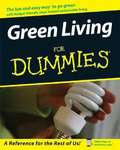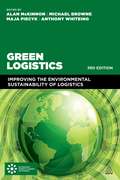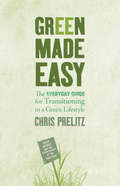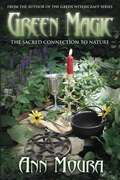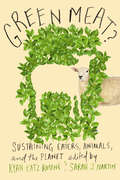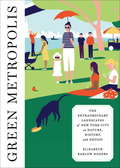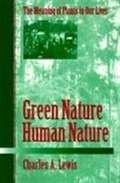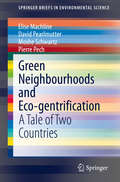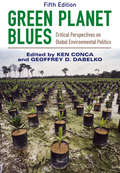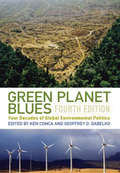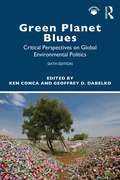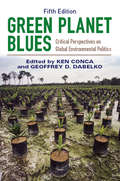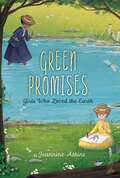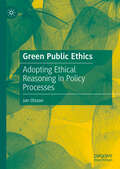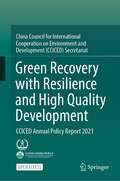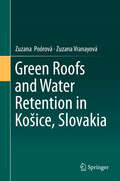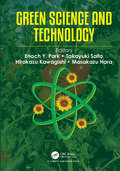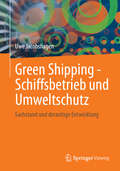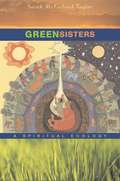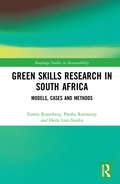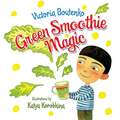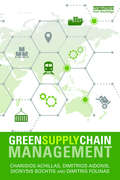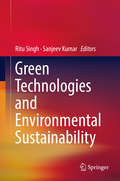- Table View
- List View
Green Living for Dummies
by Liz Barclay Michael Grosvenor Yvonne JefferyWant to do your part to reduce energy consumption, waste, and pollution; clean up the environment, and save the planet? Green Living For Dummies is packed with practical suggestions you can follow to make your lifestyle greener by doing as little damage as possible to the planet and the animal and plant life that depend on it. This practical guide delivers an array of realistic practices and changes you can undertake to help the environment and create a better home for yourself and your loved ones. You'll discover easy and innovative ways to make a difference by reducing energy use and waste, scaling back reliance on your car, and even making minor adjustments to your diet. You'll also find how to live green at work and in your community, and you'll develop a deeper understanding of how these changes benefit both the environment and your own health and well-being! Discover how to: Go green gradually. Make eco-friendly home improvements. Work greener transportation into your lifestyle. Save money by going green. Eatlocally and organically. Raise your children's environmental awareness. Reduce waste by repairing, restoring, and reusing. Become a green consumer. Invest in green companies for fun and profit. Complete with handy lists of things you can do to make a difference right away and down the road. Green Living For Dummies is the resource you need to start taking steps toward shrinking your footprint.
Green Logistics (Third Edition)
by Anthony Whiteing Alan Mckinnon Michael Browne Maja PiecykAs concern for the environment rises, companies must take more account of the external costs of logistics associated mainly with climate change, air pollution, noise, vibration and accidents. Leading the way in current thinking on environmental logistics, Green Logistics provides a unique insight on the environmental aspects of logistics. Edited by a leading team of academics with contributions from global industry leaders and researchers, it examines key issues facing the logistics industry today. Fully updated and revised, the 3rd Edition takes a more global perspective. It introduces new contributors and insightful international case studies that illustrate the impact of green logistics in practice. There is a new chapter on green hinterland logistics considering port and maritime issues written by Jean-Paul Rodrigue and Adolf Ng and four postscripts written by the editors on hot topics in the field. Ideal for use on related courses, the 3rd Edition includes indispensable online supporting materials as well as technical information and guidelines for teachers and lecturers. The book is endorsed by the Chartered Institute of Logistics and Transport (CILT).
Green Made Easy: The Everyday Guide For Transitioning To A Green Lifestyle
by Chris PrelitzGreen Made Easy is a simple-to-use guidebook offering tips on how you can make the transition toward a healthy green lifestyle one step at a time. Chris Prelitz has been passionately committed to green living and sustainability for more than 25 years. He and his wife, Becky, share a green solar-powered home in Laguna Beach, California, which Chris designed and built. Most months they produce more energy than they use and receive a credit from their power company instead of a bill. In his writing, Chris shares personal experiences, lessons learned, and reflections that humorously touch the heart and inspire the spirit. The chapter on "Green Myth Busting" will sway even the most cynical person toward better eco-choices that will also save money. Chris sees "We are rediscovering that it is so much healthier, more lucrative financially, and better for every living thing to transition away from wasteful, polluting technologies and make choices that work in harmony with nature." Green Made Easy is written in a friend-to-friend, conversational style and examines our daily lives from personal care and cosmetics to water catchment and solar systems. The book will delight and inspire any and all who dream of making a difference and who wish to create a thriving, healthy future for generations to come.
Green Magic: The Sacred Connection to Nature
by Ann MouraAuthor of the best-selling Green Witchcraft series presents a guide to understanding the mechanics of natural energies and how to use them in magical practices. Chapters on spell creating and casting; correspondences; preparation for spellwork; manipulating magical energy; purpose and method of magical work; inner magic; components of spell crafting; and magical practice.
Green Meat?: Sustaining Eaters Animals and the Planet
by Ryan M. Katz-Rosene Sarah J. MartinIt seems an irrefutable truth that raising animals for meat has become unsustainable. Land is being eroded and destroyed, water resources overdrawn, greenhouse gases overemitted, and energy and crops unnecessarily diverted - all to satiate a growing and inequitable global overconsumption of meat. But is all meat unsustainable? Sustainable food systems are multiple and varied and represent the diversity and complexity we see in the world. A range of socio-ecological and political-economic challenges and solutions are involved in the question of whether sustainable meat consumption exists. Green Meat? teases out some of that complexity in order to consider what roles animals and their products might play in the future as the world works towards new ways of living. Through an interdisciplinary lens, scholars and practitioners critically examine the multifaceted dimensions of "green meat": contributors confront the industrial production and slaughter of animals, ask what it means to be a carnivore, and consider the possibilities of regenerative animal agriculture and cellular agriculture. The book analyzes ongoing damage to the landscape, the climate, and water systems caused by conventional livestock production and looks at current debates about the place of meat in sustainable agri-food systems. An expansive inquiry into food production practices, Green Meat? will inspire the kind of discussion and debate necessary to grapple with the complex issue of sustainability.
Green Meat?: Sustaining Eaters Animals and the Planet
by Ryan M. Katz-Rosene Sarah J. MartinIt seems an irrefutable truth that raising animals for meat has become unsustainable. Land is being eroded and destroyed, water resources overdrawn, greenhouse gases overemitted, and energy and crops unnecessarily diverted - all to satiate a growing and inequitable global overconsumption of meat. But is all meat unsustainable? Sustainable food systems are multiple and varied and represent the diversity and complexity we see in the world. A range of socio-ecological and political-economic challenges and solutions are involved in the question of whether sustainable meat consumption exists. Green Meat? teases out some of that complexity in order to consider what roles animals and their products might play in the future as the world works towards new ways of living. Through an interdisciplinary lens, scholars and practitioners critically examine the multifaceted dimensions of "green meat": contributors confront the industrial production and slaughter of animals, ask what it means to be a carnivore, and consider the possibilities of regenerative animal agriculture and cellular agriculture. The book analyzes ongoing damage to the landscape, the climate, and water systems caused by conventional livestock production and looks at current debates about the place of meat in sustainable agri-food systems. An expansive inquiry into food production practices, Green Meat? will inspire the kind of discussion and debate necessary to grapple with the complex issue of sustainability.
Green Metropolis: The Extraordinary Landscapes of New York City as Nature, History, and Design
by Tony Hiss Elizabeth Barlow RogersElizabeth Barlow Rogers, the woman who launched the restoration of Central Park in the 1980s, now introduces us to seven remarkable green spaces in and around New York City, giving us the history--both natural and human--of how they have been transformed over time.Here we find: The greenbelt and nature refuge that runs along the spine of Staten Island on land once intended for a highway, where mushrooms can be gathered and, at the right moment, seventeen-year locusts viewed. Jamaica Bay, near John F. Kennedy International Airport, whose mosaic of fragile, endangered marshes has been preserved as a bird sanctuary on the Atlantic Flyway, full of egrets, terns, and horseshoe crabs. Inwood Hill, in upper Manhattan, whose forest once sheltered Native Americans and Revolutionary soldiers before it became a site for wealthy estates and subsequently a public park. The Central Park Ramble, an artfully designed wilderness in the middle of the city, with native and imported flora, magnificent rock outcrops, and numerous species of resident and migrating birds. Roosevelt Island, formerly Welfare Island, in the East River, where urban planners built a "new town in town" in the 1970s and whose southern tip is the dramatic setting for the Louis Kahn-designed memorial to Franklin Delano Roosevelt. Freshkills, the unusual twenty-two-hundred-acre park on Staten Island that is being created out of what was once the world's largest landfill. The High Line, in Manhattan's Chelsea and West Village neighborhoods, an aerial promenade built on an abandoned elevated rail spur with its native grasses and panoramic views of the Hudson River and the downtown cityscape.Full of the natural history of the parks along with interesting historical facts and interviews with caretakers, guides, local residents, guardians, and visitors, this beautifully illustrated book is a treasure trove of information about the varied and pleasurable green spaces that grace New York City.From the Hardcover edition.
Green Nature / Human Nature: The Meaning of Plants in Our Lives
by Charles A. LewisWhy are our spirits lifted by flowers, our feelings of tension allayed by a walk in a forest or park? What other positive influences can nature have on humanity?
Green Neighbourhoods and Eco-gentrification: A Tale of Two Countries (SpringerBriefs in Environmental Science)
by David Pearlmutter Elise Machline Moshe Schwartz Pierre PechThis SpringerBrief brings together a series of studies that delve into the details of French and Israeli green building practices and tell a tale of two countries which deviates considerably from what first impressions might suggest. In-depth data analysis, interviews with stakeholders, and on-the-ground documentation are used to paint a portrait of green neighborhoods in both large and small cities, and to shed light on the diversity of outcomes and the intricate web of interests leading to each one.In the Israeli cases, these dynamics reflect the fact that the private sector has become increasingly dominant in the residential building field, following a decades-long process in which the welfare state has shrunk, and the government has distanced itself from large social programs.The French solution to this dilemma is to mandate the inclusion of subsidized housing within its ecoquartiers, with the declared aim of promoting a diverse 'social mix' of population.Green building has yet to prove itself as a solution for the masses. The sale price of an apartment in a certified green building is significantly higher than what would be justified by either the additional construction costs required to build it, or the energy and water saving potential that can be realized by using it. The tale of two countries presented here suggests that neither the mechanisms of the market nor the proclamations of a welfare state can easily overcome this dilemma. What is needed is a new type of thinking, which can only emerge once the concept of "value" reflects not only the realities of a free-market economy, but also those of a planet which turns out to be distinctly limited in its resources.
Green Planet Blues
by Geoffrey D. Dabelko Edited by Ken ConcaRevised and updated throughout, this unique anthology examines global environmental politics from a range of perspectives#151;contemporary and classic, activist and scholarly#151;and reflects voices of the powerless and powerful. Paradigms of sustainability, environmental security, and ecological justice illustrate the many ways environmental problems and their solutions are framed in contemporary international debates about climate, water, forests, toxics, energy, food, biodiversity, and other environmental challenges of the twenty-first century. Organized thematically, the selections offer a truly global scope. Seventeen new readings discuss climate justice, environmental peacebuilding, globalization, land grabs, corporate environmentalism, climate adaptation, gender, disaster risk, resilience, and the future of global environmental politics in the wake of the #147;Rio+20” global summit of 2012. This book stresses the underlying questions of power, interests, authority, and legitimacy that shape environmental debates, and it provides readers with a global range of perspectives on the critical challenges facing the planet and its people.
Green Planet Blues
by Geoffrey D. Dabelko Edited by Ken ConcaRevised and updated throughout, this unique anthology examines global environmental politics from a range of perspectives#151;contemporary and classic, activist and scholarly#151;and reflects voices of the powerless and powerful. Paradigms of sustainability, environmental security, and ecological justice illustrate the many ways environmental problems and their solutions are framed in contemporary international debates about climate, water, forests, toxics, energy, food, biodiversity, and other environmental challenges of the twenty-first century. Organized thematically, the selections offer a truly global scope. Seventeen new readings discuss climate justice, environmental peacebuilding, globalization, land grabs, corporate environmentalism, climate adaptation, gender, disaster risk, resilience, and the future of global environmental politics in the wake of the #147;Rio+20” global summit of 2012. This book stresses the underlying questions of power, interests, authority, and legitimacy that shape environmental debates, and it provides readers with a global range of perspectives on the critical challenges facing the planet and its people.
Green Planet Blues: Critical Perspectives on Global Environmental Politic
by Ken Conca Geoffrey D. DabelkoRevised and updated throughout, this unique anthology examines global environmental politics from a range of perspectives: contemporary and classic, activist and scholarly, and reflecting voices of the powerless and powerful. Paradigms of sustainability, environmental security, and ecological justice illustrate the many ways environmental problems and their solutions are framed in contemporary international debates about climate, water, forests, toxics, energy, food, biodiversity, and other environmental challenges of the twenty-first century. Organized thematically, the selections offer a truly global scope. Fourteen new readings discuss globalization and environmental change; transnational activist networks; the UN Environment Programme; environment-conflict linkages, including the case of Darfur; environmental peacebuilding; the debate on greening foreign aid; and the linkages between climate change and human rights. This book stresses the underlying questions of power, interests, authority, and legitimacy that shape environmental debates, and it provides readers with a global range of perspectives on the critical challenges facing the planet and its people.
Green Planet Blues: Critical Perspectives on Global Environmental Politics
by Ken Conca Geoffrey D. DabelkoRevised and updated throughout, this unique anthology examines global environmental politics from a range of perspectives and captures the voices of both the powerless and the powerful. Paradigms of sustainability, environmental security, and ecological justice illustrate the many ways environmental challenges and their solutions are framed in contemporary international debates about climate, water, forests, toxics, energy, food, and biodiversity. Organized thematically, the selections offer a truly global scope. Seventeen new readings explore climate justice, globalization, land and water grabs, climate change and conflict, China’s international environmental relations, and the future of climate politics in the wake of the Paris Agreement. This book stresses the underlying questions of power, interests, authority, and legitimacy that shape environmental debates, and it provides readers with a global range of perspectives on the critical challenges facing the planet and its people. This new edition of Green Planet Blues connects directly with a wide-range of upper-level undergraduate and graduate-level courses.
Green Planet Blues: Critical Perspectives on Global Environmental Politics (5th Edition)
by Ken Conca Geoffrey D. Dabelko<p>Revised and updated throughout, this unique anthology examines global environmental politics from a range of perspectives (contemporary and classic, activist and scholarly) and reflects voices of the powerless and powerful. Paradigms of sustainability, environmental security, and ecological justice illustrate the many ways environmental problems and their solutions are framed in contemporary international debates about climate, water, forests, toxics, energy, food, biodiversity, and other environmental challenges of the twenty-first century. Organized thematically, the selections offer a truly global scope. Seventeen new readings discuss climate justice, environmental peacebuilding, globalization, land grabs, corporate environmentalism, climate adaptation, gender, disaster risk, resilience, and the future of global environmental politics in the wake of the 'Rio+20' global summit of 2012. <p>This book stresses the underlying questions of power, interests, authority, and legitimacy that shape environmental debates, and it provides readers with a global range of perspectives on the critical challenges facing the planet and its people.</p>
Green Promises: Girls Who Loved the Earth (Girls Who Love Science)
by Jeannine AtkinsMeet three remarkable women who followed their dreams and paved a path for women in science in this gorgeously written biographical novel in verse from acclaimed author Jeannine Atkins.As a girl in the late 1800s, Mary Agnes Chase searched the river&’s edge for wild grasses, wondering how best to capture their likeness with pencil and paper. While her formal education ended in eighth grade, her skill at drawing plants helped land her a position at the Smithsonian Institution. Agnes became a world-renowned expert in grasses she discovered in meadows and mountains. Far away on the bank of another river, Marguerite Thomas Williams waded in to explore the rocks, wondering what secrets they might tell of long ago. Marguerite became a schoolteacher, then a teacher of teachers, but she wanted more. At last, a nearby university opened its doors to Black women, and after years of study, Marguerite became the first Black woman to earn a PhD in geology. Marguerite&’s student Sophie Mack Lutterlough&’s lifelong interest in insects led to her working her way from being an elevator operator at the Smithsonian Institution to becoming one of the first Black women researchers there in the late 1950s. With keen eyes and ambition, each woman followed her love of the natural world to blaze a trail for future female scientists.
Green Public Ethics: Adopting Ethical Reasoning in Policy Processes
by Jan OlssonThis book argues that ethical reasoning should be adopted into policy processes in order to improve environmental regulations. It considers how public administrators and civil servants play key roles in policy making and implementation, and demonstrates how the inclusion of green public ethics at every stage of the policy process could drastically enhance sustainable development initiatives. Filling an important void in the literature on policymaking and environmental ethics, the book draws from empirical case studies to demonstrate how ‘green’ ethical reasoning can be utilised by practitioners and stakeholders in democratic governments. It will appeal to all those interested in public policy, public administration, philosophy and environmental studies.
Green Recovery with Resilience and High Quality Development: CCICED Annual Policy Report 2021
by CCICEDThis open access book is based on the research outputs of China Council for International Cooperation on Environment and Development (CCICED) in 2021. It covers major topics of Chinese and international attention regarding green development, such as climate, biodiversity, ocean, BRI, urbanization, sustainable production and consumption, technology, finance, value chain, and related topics. It also reviews the progress of China‘s environmental and development policies and the impacts from CCICED. This is a highly informative and carefully presented book, providing insight for policy makers in environmental issues.
Green Roofs and Water Retention in Košice, Slovakia
by Zuzana Poórová Zuzana VranayováThis book discusses how climate change and heat islands are a main contributor to water related problems in urban areas in Košice, Slovakia. Green roofs are used as a tool to assist in solving these water related issues. The need to provide housing in urban areas is expected to rise to 66% in 2050, according to the United Nations. Many urban areas have seen natural permeable green areas replaced with concrete constructions and hard, non-permeable surfaces. The densification of existing built-up areas is responsible for the decreasing vegetation, which results in the lack of evapotranspiration cooling the air, thereby creating urban heat islands. Several studies, discussed in this book, have shown that natural and permeable surfaces, as in the case of green roofs, can play a crucial role in mitigating this negative climate phenomenon and providing higher efficiency for buildings, leading to savings such as water, one of the focal points of this research.
Green Science and Technology
by Enoch Y. Park Takayuki Saito Hirokazu Kawagishi Masakazu HaraThis book provides a comprehensive and up-to-date review of recent trends of green science and technology. Worldwide deterioration of environment and global warming threaten our lifestyle and the survival of all creatures. In order to weather these problems, we need to construct a multidisciplinary approach involving the fusion of various advanced researches. The book begins with an overview on fundamental research about generation and utilization of renewable energy, protection of the earth's ecosystem for better coexistence with nature, development of artificial intelligence-based agriculture and molecular recognitionbased welfare and covers a wide range of innovative research on green science and technology.
Green Shipping - Schiffsbetrieb und Umweltschutz: Sachstand und derzeitige Entwicklung
by Uwe JacobshagenKurzbeschreibung: Ergänzend zu den im Springer Vieweg-Verlag erschienen Büchern „Schiffsbetriebstechnik“ (Dr. Pfaff), „Umweltschutz und Gefahrguttransport für Binnen- und Seeschifffahrt“ (Jacobshagen) sowie „Wasserwirtschaft in der gewerblichen Schifffahrt“ (Jacobshagen) sollen die Zusammenhänge zwischen dem notwendigen Einsatz von Technik für den Schiffsbetrieb und die daraus resultierenden Einflüsse auf die Umwelt, insbesondere der Meeresumwelt, dargestellt werden. Es werden dazu die technischen Vorgänge an Bord von See- und Binnenschiffen sowie von Sportbooten beschrieben und die vorhandenen sowie entworfenen Rechtsgrundlagen erläutert. Der Einfluss der Schiffsbetriebstechnik auf den Umweltzustand soll dabei durch Statistiken, Einzelfälle und Sachverhalte erklärt werden. Besonderer Bedeutung kommt dabei der Verwendung von Betriebsstoffen zu, wobei die Arten und insbesondere Alternativen beschrieben werden sollen.
Green Sisters: A Spiritual Ecology
by Sarah Mcfarland TaylorGreen Sisters gives us a firsthand understanding of the practice and experience of women whose lives bring together Catholicism and ecology, orthodoxy and activism, traditional theology and a passionate mission to save the planet. As green sisters explore ways of living a meaningful religious life in the face of increased cultural diversity and ecological crisis, their story offers hope for the future--and for a deeper understanding of the connections between women, religion, ecology, and culture.
Green Skills Research in South Africa: Models, Cases and Methods (Routledge Studies in Sustainability)
by Heila Lotz-Sisitka Eureta Rosenberg Presha RamsarupThis book proposes transformative, realist methodology for skills research and planning through an analysis of case studies of the changing world of work, new learning pathways and educational system challenges. Studies of the green economy and sustainability transitions are a growing field internationally, however there are few books that link this interest to the development of skills. This book draws on, and showcases, the experience and insights of researcher-practitioners who are at the cutting edge in this emerging field, internationally and in South Africa. The context for this book is South Africa, but application is worldwide. In many ways indicative of the global picture, South Africa is in the grip of economic and environmental imperatives, searching for safe and just transitions. The authors present a new, embedded transitioning systems model for studying skills for a sustainable, just future. This book will be of great interest to students and scholars of sustainable development, ecological economics and skills planning.
Green Smoothie Magic
by Victoria BoutenkoVictoria Boutenko responds to the crisis of childhood obesity with a story that makes children excited about nutrition, healthy foods, vegetables and fruits, green smoothies, and the science of plants. This kids' book follows young Nic as he discovers the importance of healthy eating with a plant-rich diet and learns to invent his own healthy recipes for kids. With a pilot father and an artist mother, Nic is an inquisitive child with a fondness for magic. One day, he asks his father where trees come from and is amazed to learn they come from small acorn seeds that grow powered by the sun. His father tells him about the magical green juice, chlorophyll, in all plants. Since humans can't grow with sunlight alone and we don't make our own magical green juice, we need to eat plants to grow big and strong like the oak trees Nic is so fascinated by. Eager to grow big and strong, Nic goes home that night determined to eat more vegetables. He's quickly disheartened when he is put off by the bitter taste of lettuce. But his mother thinks of a way to ensure he can have a tasty, healthy diet. Buying a blender the next day, she whips up some raw-food green smoothie magic. Nic is hesitant at first, but his natural curiosity wins out, and he is soon asking for seconds. The story ends with Nic's own smoothie recipe. Combining sweet fruits with green vegetables, this kids' food recipe promises to be a favorite with children and picky eaters everywhere.
Green Supply Chain Management
by Dimitrios Aidonis Dimitris Folinas Charisios Achillas Dionysis D. BochtisToday, one of the top priorities of an organization’s modern corporate strategy is to portray itself as socially responsible and environmentally sustainable. As a focal point of sustainability initiatives, green supply chain management has emerged as a key strategy that can provide competitive advantages with significant parallel gains for company profitability. In designing a green supply chain, the intent is the adoption of comprehensive and cross-business sustainability principles, from the product conception stage to the end-of-life stage. In this context, green initiatives relate to tangible and intangible corporate benefits. Sustainability reports from numerous companies reveal that greening their supply chains has helped reduce operating cost, thus boosting effectiveness and efficiency while increasing sustainability of the business. Green Supply Chain Management provides a strategic overview of sustainable supply chain management, shedding light on the theoretical background and key principles of the topic. Specifically, this book covers various thematic areas including benefits and impact of green supply chain management; enablers and barriers on supply chain operations; inbound and outbound logistics considerations; and production, packaging and reverse logistics under the notion of "greening". The ultimate aim of this textbook is to highlight the challenges in the implementation of green supply chain management in modern companies and to provide a roadmap for decision-making in real-life cases. Combining chapter summaries and discussion questions, this book provides an accessible and student-friendly introduction to green supply change management and will be of great interest to students, scholars and practitioners in the fields of sustainable business and supply chain management.
Green Technologies and Environmental Sustainability
by Sanjeev Kumar Ritu SinghIn the present scenario, green technologies are playing significant role in changing the course of nation's economic growth towards sustainability and providing an alternative socio-economic model that will enable present and future generations to live in a clean and healthy environment, in harmony with nature. Green technology, which is also known as clean technology, refers to the development and extension of processes, practices, and applications that improve or replace the existing technologies facilitating society to meet their own needs while substantially decreasing the impact of human on the planet, and reducing environmental risks and ecological scarcities. The concepts of Green Technologies, if endorsed and pervaded into the lives of all societies, will facilitate the aim of the Millennium Development Goals of keeping the environment intact and improve it for the civilization to survive. Green Technologies and Environmental Sustainability is focused on the goals of green technologies which are becoming increasingly important for ensuring sustainability. This book provides different perspectives of green technology in sectors like energy, agriculture, waste management and economics and contains recent advancements made towards sustainable development in the field of bioenergy, nanotechnology, green chemistry, bioremediation, degraded land reclamation. This book is written for a large and broad readership, including researchers, scientists, academicians and readers from diverse backgrounds across various fields such as nanotechnology, chemistry, agriculture, environmental science, water engineering, waste management and energy. It could also serve as a reference book for graduates and post-graduate students, faculties, environmentalist and industrial personnel who are working in the area of green technologies.
